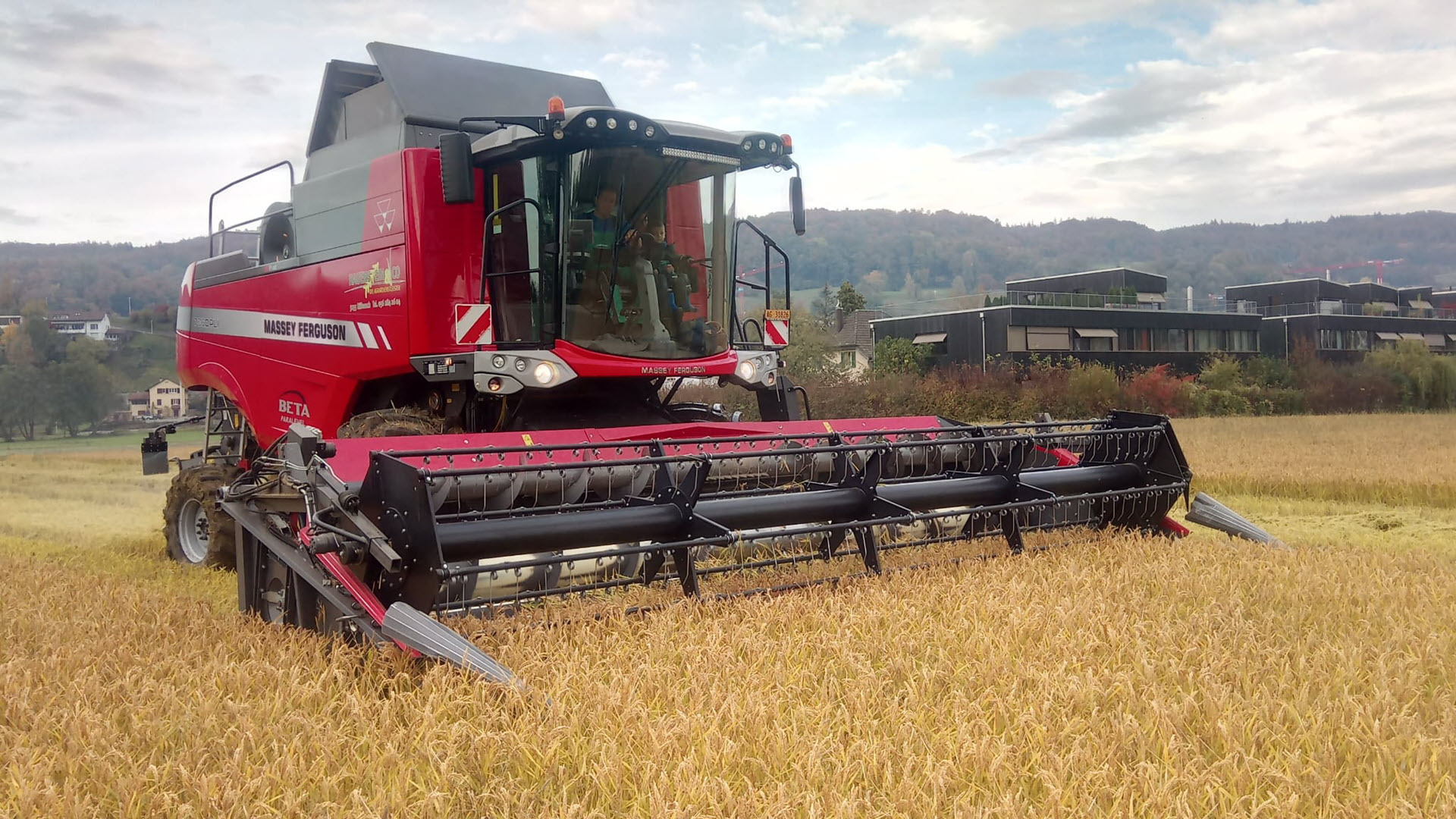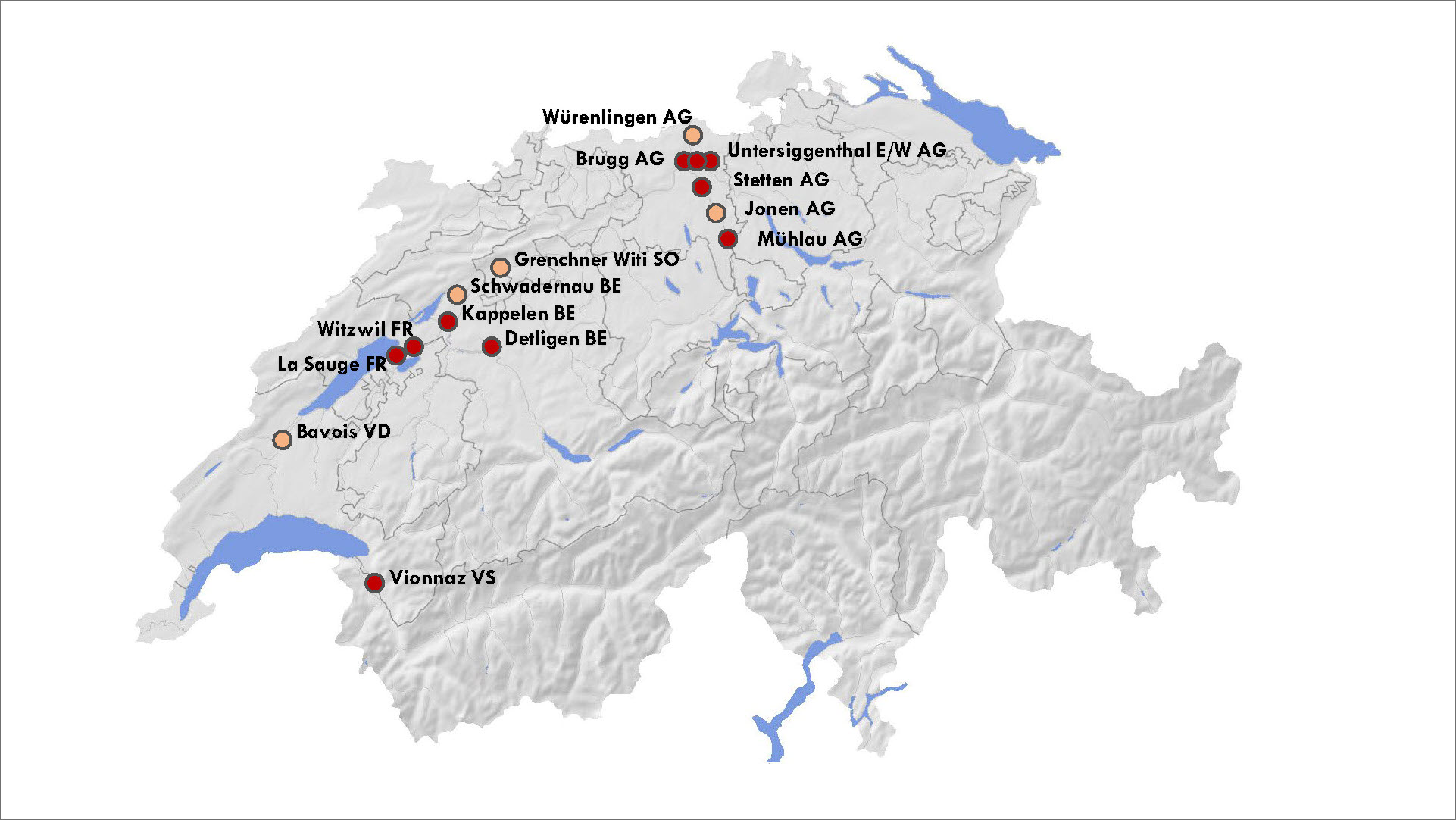Before renovating irrigation and drainage systems and implementing soil improvement measures, alternatives should be considered. The value of temporarily flooded land has increased significantly in recent years as rice production has gained a foothold on it. The cultivation of rice on temporarily flooded land leads to the creation of new wetlands. The animal and plant species found in such areas are now particularly endangered due to a lack of habitat. Rice cultivation promotes moisture-loving species as well as bringing new, competitive Swiss products onto the market. Demand for domestic rice is very high – it usually sells out in farm shops and online before the summer.

Pilot paddy-rice fields in Switzerland, supported by Agroscope
Since 2017, Agroscope has combined forces with innovative farmers to study the cultivation of ecological paddy rice north of the Alps. ‘Ecological’, because the main aims here besides successful cultivation are the promotion of wetland-loving species (plants, insects, amphibians and birds) and environmentally friendly management (no use of plant-protection products).
Paddy-rice cultivation has expanded steadily in Switzerland since 2017, with an increase in the number of farmers, fields and areas (Table 1).
Since 2023, rice paddies can be declared as biodiversity promotion areas and count towards BPAs on agricultural land. Farmers are thus able to receive subsidies and recognition for their pioneering work. This also represents a positive outcome for the fauna that thrives on the rice fields, including numerous common species such as water frogs (Pelophylax sp.) and Odonata species (e.g., Sympetrum fonscolombi) as well as endangered species such as spotted darters (Sympetrum depressiusculum), natterjack toads (Epidalea calamita), tree frogs (Hyla arborea), barred grass snakes (Natrix natrix), lapwings (Vanellus vanellus) and wading birds like the common sandpiper.
|
|
Paddy-rice area (ha) |
|
|
|||||
|---|---|---|---|---|---|---|---|---|---|
|
Canton |
2017 |
2018 |
2019 |
2020 |
2021 |
2022 |
2023 |
2024 |
Grenchener Witi |
SO |
0.3 |
|
|
|
|
|
|
|
Schwadernau |
BE |
|
0.2 |
0.8 |
0.8 |
1.3 |
1.3 |
1.5 |
1.5 |
Bavois |
VD |
|
|
0.9 |
0.9 |
0.9 |
0 |
0 |
0 |
La Sauge |
FR |
|
|
0.4 |
1.8 |
1.8 |
3 |
6 |
9 |
Witzwil |
BE |
|
|
0.5 |
0.4 |
0.4 |
0.4 |
0.4 |
0.4 |
Brugg |
AG |
|
|
1.2 |
2.3 |
2.3 |
2.3 |
2.3 |
2 |
Untersiggenthal - West |
AG |
|
|
|
0.7 |
0.7 |
0.7 |
0.7 |
0.7 |
Turgi |
AG |
|
|
|
0.5 |
0.5 |
0.5 |
0.5 |
0.5 |
Würenlingen |
AG |
|
|
|
1.2 |
1.2 |
1.2 |
1.2 |
0 |
Vionnaz |
VS |
|
|
|
1 |
0 |
1 |
1 |
1 |
Detligen |
BE |
|
|
|
|
0.8 |
0.8 |
0.8 |
0.8 |
Stetten |
AG |
|
|
|
|
0.5 |
0.5 |
0.5 |
1.5 |
Mühlau |
AG |
|
|
|
|
1 |
1 |
1 |
1 |
Jonen |
AG |
|
|
|
|
1 |
1 |
1 |
0 |
Kappelen |
BE |
|
|
|
|
|
|
2 |
2 |
Total paddy-rice area per year |
|
0.3 |
0.2 |
3.8 |
9.6 |
12.4 |
13.7 |
18.9 |
20.4 |
Results of Agroscope research
Paddy rice can be a financially worthwhile crop in Switzerland.
The sites should be on the Central Plateau at low altitudes, where summer temperatures are warm enough for rice to flourish. Sufficient water (approx. 5,000m3) that can be distributed with the use of powerful pumps under regular supervision should be available near the fields to maintain a water level of up to 20cm throughout the season.
Since it is grown without pesticides, paddy rice is an attractive crop for the environment as well as for environmentally aware and health-conscious consumers. Consequently, it sells successfully online and in farm shops, enabling farmers to make a satisfactory profit. This is clearly reflected in the steadily increasing area devoted to paddy rice in recent years.
Paddy-rice cultivation also benefits nature conservation: wet areas are unusual in the otherwise-dry agricultural landscape, providing additional habitat in which rare animal species such as amphibians and dragonflies can flourish. Our studies of dragonflies on rice paddies have shown that fertilisation does not pose a problem for these species and causes no developmental delays or mortality. The breeding success of lapwings in three paddy-rice fields is particularly encouraging. Biodiversity surveys have confirmed the win-win for agriculture and biodiversity arising from the use of wet farmland for rice cultivation.
Although weed pressure is high on many fields, it can be brought under control without herbicides by using appropriate cultivation methods. Planting 2-to-4-week- old rice plants is better than sowing, since the developmental advantage at the end of the short growing season has proven crucial for successful yields. This also shifts the competition with weeds in favour of the rice plants. Regular manual weeding, especially before the weeds flower, is essential, representing the greatest cost and time factor for farmers. Water management is important for reducing these costs, and crop rotation should be considered if weed pressure is too high.
Compared to ‘dry’ cultivation, paddy-rice cultivation can significantly reduce greenhouse gas emissions from organic soils. This has been demonstrated in a mesocosm trial and is being field-tested in an ongoing project.
In addition to the established risotto variety ‘Loto’, our variety trials have highlighted a promising sushi variety suitable for Switzerland’s cool climatic conditions. Most farmers in Switzerland grow Loto, but some are successfully raising new varieties of sushi, nero and jasmine rice on their paddies, which are highly rated by consumers. Tests with further varieties from e.g. Hokkaido (Japan), northeast China, Ukraine or Russia could identify a wider range.
Publications
Ökologischer Nassreis-Anbau auf vernässenden Ackerflächen in der Schweiz
(Faktenblatt agridea: Informationen zur Anbautechnik und zur Förderung der Biodiversität auf Nassreisfeldern)
Links
Webseiten zu Landwirtschaftsbetrieben mit Nassreisanbau und Verkauf
Multimedia
Agroscope, 24.01.2025: Erste Erfahrungen der Nassreis-Pioniere
RTS, 8.12.2022: La culture du riz commence à se développer en Suisse romande. C'est une des conséquence du réchauffement climatique
Radio 1, 16.11.2022: Der Reisanbau in der Schweiz fördert seltene Arten
Yvonne Fabian im Interview (MP3, 2 MB, 22.11.2022)Agroscope-Projektleiterin Yvonne Fabian erklärt, weshalb der Reisanbau in der Schweiz heute möglich ist und erst noch die Biodiversität erhöht.
SRF, nano vom 30.09.2021: Nassreis-Anbau: Win-win für Landwirte & Artenschutz
Schweiz aktuell, 23.10.2019: Nassreisanbau im Seeland
ETH Vortrag, Yvonne Fabian: Nassreis-Anbau als Erfolgsgeschichte
Schweiz aktuell, 2.07.2019: Reis aus dem Schweizer Seeland
Press review
Pressespiegel Reisanbau Schweiz (PDF, 212 kB, 19.02.2025)Press Release Paddy Rice Cultivation in Switzerland (german)
Partner
- School of Agricultural, Forest and Food Sciences HAFL
- IG Nassreis
- Federal Office for Agriculture FOAG
- Federal Office for the Environment FOEN
- Cantons of Aargau, Bern, Fribourg, Solothurn, Vaud and Valais
- Agricultural businesses of Leandre Guillod (FR), Stephan Angst (VS), Alain Salzmann (VD), JVA Witzwil (BE), Stephan Gerber (BE), Sandro Märki (AG), Fredy Umbricht (AG), Janis Looser (AG), Michael Rüttimann (AG), Peter & Mathias Suter (AG), Lukas & Natalie Neuhaus (AG), Schwarz AG (AG)
- Swiss Ornithological Institute, Sempach and Valais
- Coordination Office for Amphibian and Reptile Protection in Switzerland (karch)
- Agridea
- SNF Bridge Discovery Fund
- Ernst Göhner Foundation
- Soil Science Unit, Institute of Geography, University of Bern
Contact







